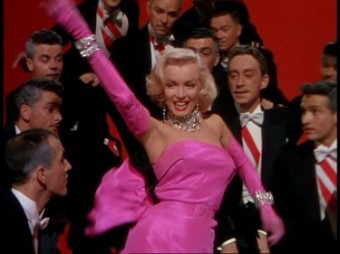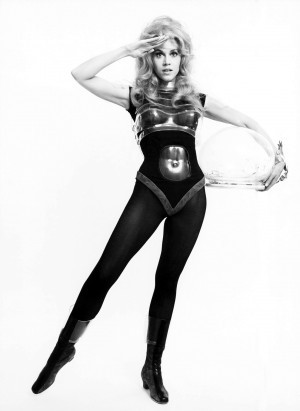How Much More Are Movie Stars Making Today?
How Much More Are Movie Stars Making Today?

We all know that our movie stars are not only a precious natural resource, but also a group of individuals that are very highly compensated, not just now, but even back then, when we were just figuring out what to call them (moving picture heroes? Lumièronauts?). We also all know that this compensation has increased as the years tick by and the Oscars are doled out. But do we know exactly by how much?
It’s not a question that’s entirely straightforward. For example, the answer to the trivia question, “Who was the first actor to get paid a million dollars for a single movie?” is a surprisingly hard one to answer. The game show answer would be William Holden for The Bridge On The River Kwai in 1957 (and, on the actress side, Elizabeth Taylor for Cleopatra in 1963). But not so fast. Holden made a million dollars off the film, but actually his upfront compensation was less than $500,000, as his agent negotiated a deal where Holden would get ten percent of the film’s profits. And as such arrangements go, how much did Mary Pickford, Douglas Fairbanks, Charlie Chaplin and (non-actor) D.W. Griffith make after they formed United Artists in 1919, as they produced and distributed a number of films that grossed over a million dollars at the time. They owned the means of production, and were surely making serious bank, not just as actors but also as distributors.
And for that matter, is it fair to compare a million dollars in 1919 to a million dollars in 1957? Or even 1957 to 1963? “Who is William Holden?” might take the square on “Jeopardy,” but it also might not be correct.
BRAD PITT
As a baseline, let’s use Brad Pitt, currently appearing in critical pick Moneyball. Pitt has been around for a while, and his ascent to stardom was steep, initially attracting close attention as the abs in Thelma and Louise in 1991, jetting straight to above the title in short order. This is common knowledge, and Brad Pitt has as household of a name as they come for coming on 20 years, and a favorite topic of the gossip industrial complex. But just how much money does Shawnee, Oklahoma’s William Bradley Pitt actually make? To the Internet!
Do keep in mind that an actor’s salary is not necessarily a matter of public record. Movie-making in not like professional sports, where paycheck size is disclosed as a matter of course. It makes sense: how much do you make a year, and how likely are you to answer that question in a public forum? On top of that, generally speaking, the size of a budget of a motion picture falls under the category of trade secret, as competing studios don’t exactly what to advertise how much money they are (or aren’t) making to competitors.
On the other hand, some salaries are bandied about like catchphrases. Take the
$20 million dollar club, which is the recent standard for the highest echelon of movie stars, including Tom Hanks, Julia Roberts, Jim Carrey, Harrison Ford and Johnny Depp. Why advertise such an obscene take-home? Answer: So that the actor is viewed as someone who must be paid that much for the next film.
In Pitt’s case, according to IMDB, Pitt’s reps fall on the side of building precedent by releasing (usually through sub rosa means) some of his paydays. Pitt made his first serious bank in 1993, turning his hot guy charm into menacing hot guy for Kalifornia for $500,000. His menacing maybe-imaginary hot guy reprise in 1999 Fight Club made him $17,500,000. And in 2005 he joined the $20 million club for the film he made with Mrs. Pitt, Mr. & Mrs. Smith. By any standard other than a hedge fund manager’s, Brad Pitt gets paid a lot of money.
MARILYN MONROE

And if we are going to objectify Brad Pitt, let’s look at the salaries of Marilyn Monroe, or as she was known then, Marilyn Freakin’ Monroe.
One thing to keep in mind when discussing what actors got paid in times past is that up until the 1970s, it was very common for an actor to sign a term deal with a studio instead of negotiating compensation for each individual film. If you were an aspiring actor in, say, the 1930s, your breakthrough would most likely come while you were under contract to one of the major studios, which would pay you a fixed weekly amount. It was possible to get to the point where the actor would have the negotiating leverage, but to get to that point was a question of doing time as a bit player, playing in roles designated by the employer, until popular acclaim could be acquired.
As Monroe began to break into stardom, she was under contract to 20th Century Fox, who paid her $1,250 a week for Gentlemen Prefer Blondes (later to be memorialized as a Madonna music video ) in 1953. Three years later, her pay had increased to $100,000 for a serious turn in Bus Stop, the result of a renegotiated deal with Fox that gave her a per-picture fee plus approval rights over roles and production elements, and the right to make films for other studios. Which she did in 1961, filming The Misfits for United Artists for $250,000, a tumultuous production that would be the last completed film for both Monroe and Clark Gable. (Numbers via IMDb.)
WILLIAM POWELL
Let’s go back even further and look at the career of an actor possessing, for the time, a certain Brad Pitt-level of fame: William Powell. Powell was handsome and debonair, though he did rise to fame by playing heavies and hobos, with a career that spanned silent films into the advent of the talkies. Powell (who you surely remember from The Thin Man at least, right?) was as embroiled in the gossip headlines of his day as is Pitt. Powell was not only briefly married to Carole Lombard, he was the beau of Jean Harlow at the time of her untimely death at the age of 26. So how’d Bill Powell do?
According to William Powell: The Life and Films by Roger Bryant (a charming if not obsessive little bio), we know that in 1928 Powell was paid a total of $5,200 for both his and Paramount’s first talkie, Interference. By 1934, when The Thin Man was produced, Powell was under contract for $3,000 a week. And two years later Powell co-starred with ex-wife Lombard in My Man Godfrey (a film which introduced us to the sadly fallen-into-disuse term “forgotten man”) for $87,500.
JANE FONDA

Finally, let’s take second-generation star Jane Fonda. She got into the business the conventional way as a Hollywood player, eventually garnering acclaim for Cat Ballou in 1965, but broke through as a household name after a spell in Europe with then-husband Roger Vadim, resulting in mod/sci-fi Barbarella. Of the films for which info is available (again, via IMBd), we know that: in 1973, five years after Barbarella put her on the map, she was paid $100,000 for post-hippie comedy Steelyard Blues, for Neil Simon-penned California Suite in 1978 she made $500,000, and then $2 million for 1980’s (and eventual Broadway show) Nine to Five.
All of these figures beg the question of total compensation, of course. For nearly as long as there has been a film industry actors have been enticed into making a film in exchange for a simple participation in the net profits. And more recently, an even more exclusive club than the $20 million dollar club has emerged: the first-dollar-gross club, made up of actors who are paid not a percentage of profits, but a percentage of revenue received from exhibitors. Leonardo DiCaprio got that for Matrix-come-lately Inception, which earned DiCaprio the respectable (reputed) amount of $50 million, which, at the prime rate or 3.25%, would provide, around $1.75 million per year.
Please note that the description of the ways that actors get paid is a deliberate simplification for the purposes of clarity. If understanding how it actually works is something you’d like to spend an afternoon doing, start here.
So then, four different actors, spaced relatively evenly over 70 years apart: who made/makes more? Below are the referenced film/salaries, adjusted to reflect 2011 dollars (using the Bureau of Labor Statistics invaluable consumer price index calculator).
WILLIAM POWELL
Interference (1928): $68,890.88
The Thin Man (1934): $50,719.03 per week
My Man Godfrey (1936): $1,426,092.63
MARILYN MONROE
Gentlemen Prefer Blondes (1953): $10,606.04
Bus Stop (1956): $832,886.03
The Misfits (1961): $1,894,188.96
WILLIAM HOLDEN
The Bridge on the River Kwai (1957): $8,062,099.64
ELIZABETH TAYLOR
Cleopatra (1963): $7,403,431.37
JANE FONDA
Steelyard Blues (1973): $510,236.49
California Suite (1978): $1,737,308.28
Nine to Five (1980): $5,498,665.05
BRAD PITT
Kalifornia (1993): $807,359.23
Fight Club (1999): $23,796,743.70
Mr. & Mrs. Smith (2005): $23,199,692.78
LEONARDO DICAPRIO
Inception (2011): $50,000,000
What have we learned from all of these numbers? It seems to be a pretty clear progression (given the meager sample size) — generally speaking, in 2011 dollars, actors have been getting paid more and more over time. To wit, Pitt as Tyler Durden made exactly 200 times as much as Powell did as Godfrey, although that multiplier is reduced to a little under 17 when you adjust for inflation. In fact, if you ignore the little bumps from Holden and Taylor (both of whom were paid the most ever, at the time), it seems like a steady increase until you get to the present day, when compensation is looking for the proverbial roof to shoot through. And of course we’re talking about the highest end of the business. Screen Actors Guild minimum scale has been raised pretty much in line with inflation, and is currently set at a comfortable-but-not-exorbitant $2,864 a week, which is not exactly a boatload of money, especially considering the seasonal nature of an actor’s employment.
To get paid what William Powell got paid would provide for a nice little existence. But to be paid what Leonardo gets paid? It must be literally beyond imagination. (Speaking of which, no, I still haven’t watched all of Inception.)
Brent Cox is all over the Internet.
Photo of Pitt by Joe Seer, via Shutterstock.
